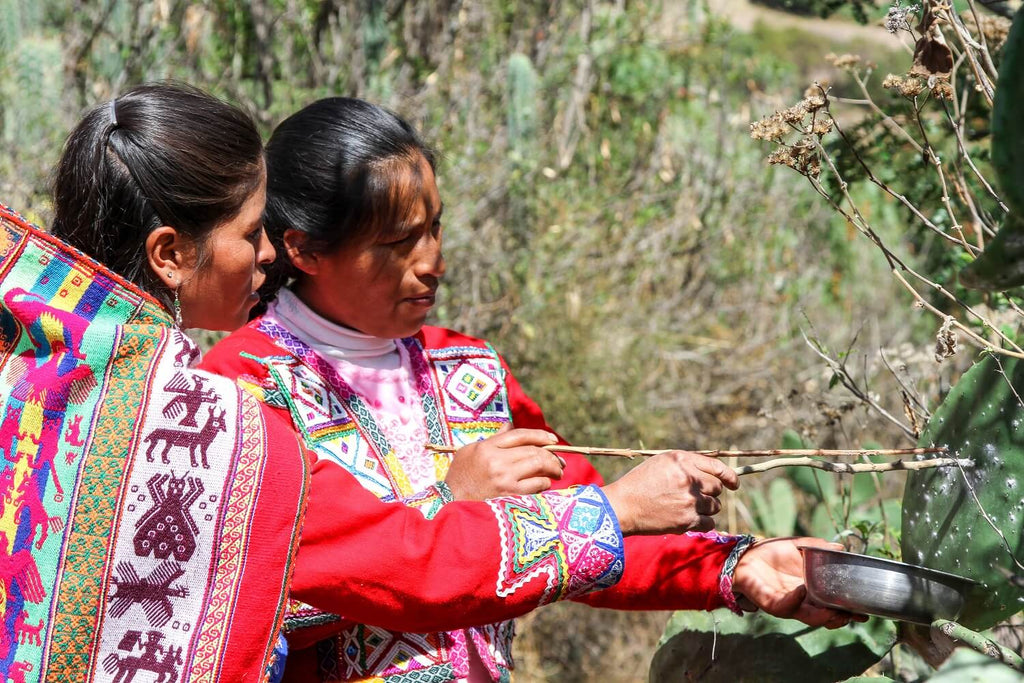At Threads of Peru, we believe in providing a more sustainable future for the textile and clothing sector, linking fashion with awareness and responsibility.

Martina, a weaver from Chaullacocha, spins her alpaca fibre while chatting with Chaska, one of our models, wearing the Angelina alpaca ruana, which is made in Chaullacocha using yarn spun from the weavers' own alpaca herds. Photo by: Luis Figueroa.
That means we want to produce fashion accessories and home textiles without harming the planet. As part of our commitment to environmental sustainability, we create low-impact products that don’t add anything dangerous to the local environment, and also don’t remove more materials from the environment than can naturally be replaced.
Our products foster ecological sustainability through the use of 100% natural materials: ethically raised alpaca fibre and sheep wool, and natural dyes.

Locally collected and subsequently dried tara seed pods spread on the table beside bowls of qollpa (a mineral used as a fixative and mordant) and dried cochineal - all ready for a day of dyeing! Photo by: Meghan Black.
Everything we produce is made using either sheep wool or alpaca fibre. Alpacas and sheep are raised in the rural Andean communities where we work, according to traditional, free range practices. During the day, they wander the Andean landscape to graze, and return to their shelters in the community at night. Alpacas are sheared by hand once every two years. This is often accompanied by a blessing ceremony, both to honour the animals and to ensure a bountiful supply of fleece.

Cute and fuzzy alpacas graze in the community of Upis against a mountainous backdrop. Photo by: Alexa Jones.
> Read more about the health benefits of alpaca fibre!
Many of our products feature undyed fibre which can come in a dozen different shades of white, brown, grey and black, in the case of alpaca. For anything coloured, we use natural dyes. There are dozens of plants, minerals and insects that can be found locally and which produce a rich array of colours – from vibrant reds, to bright yellows, deep greens and even turquoise!

Threads of Peru team members Ligia Gomez and Lourdes Hancco inspect some alpaca fleece in Upis. Photo by: Anne Laure Camilleri.
Most of these materials are harvested from the wild by the artisans themselves, while others are traded between communities, or purchased from medium-sized regional suppliers, as in the case of cochineal.

Herminia and her fellow weaver harvest some fresh cochineal during a dye workshop and demonstration in Huaran.
Because we create limited-run handmade collections, our production is small enough that we are not at risk of over-harvesting these natural resources. Through the wisdom of the artisans we work with, we understand and respect the harvesting season for each plant. This means that some plants are not available at certain times of year. We work this into how we design and produce our collections.

Lourdes and Angela discussing colours and how to achieve them with available resources. Photo by: Sarah Confer.
Using natural materials is an important way of protecting the natural environment. Since the weavers work at home, they are using local sources of water for dyeing, and the left over water is discarded into the landscape. Using natural plants and minerals for dyeing means that there is little risk of polluting important water sources in the communities, or introducing toxins into the environment.

A weaver in Rumira Sondormayo rinses her yarn in the stream. Photo by: Isaiah Brookshire.

